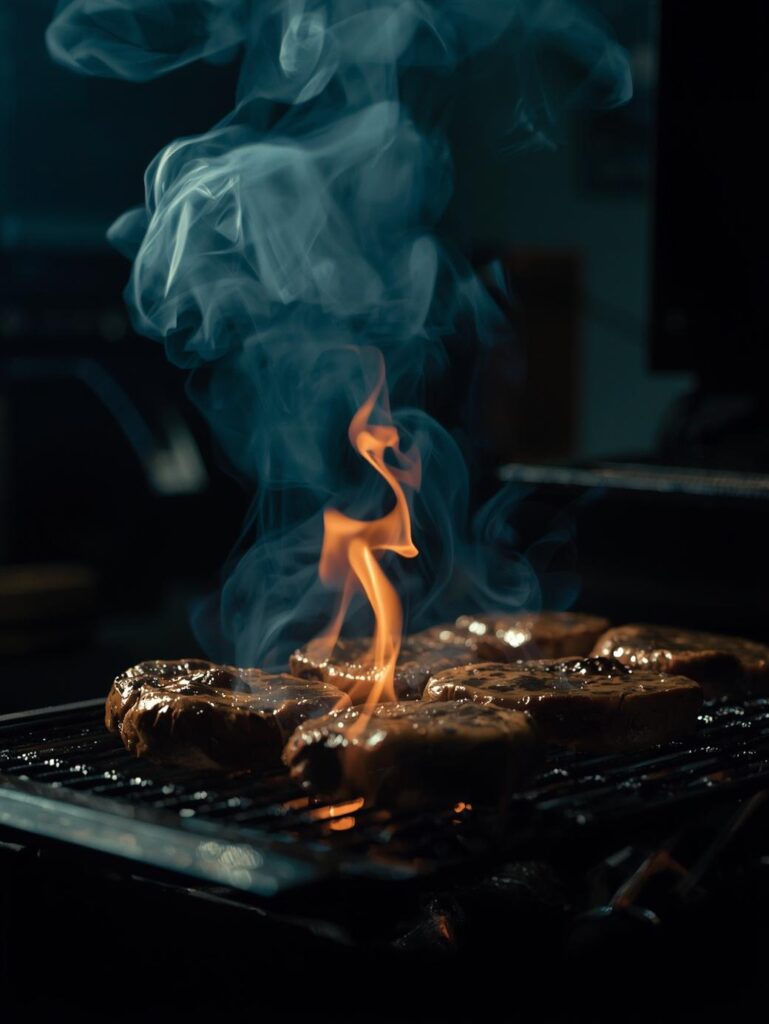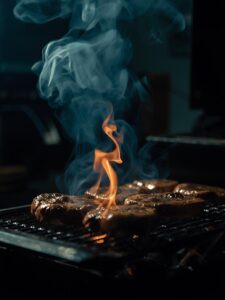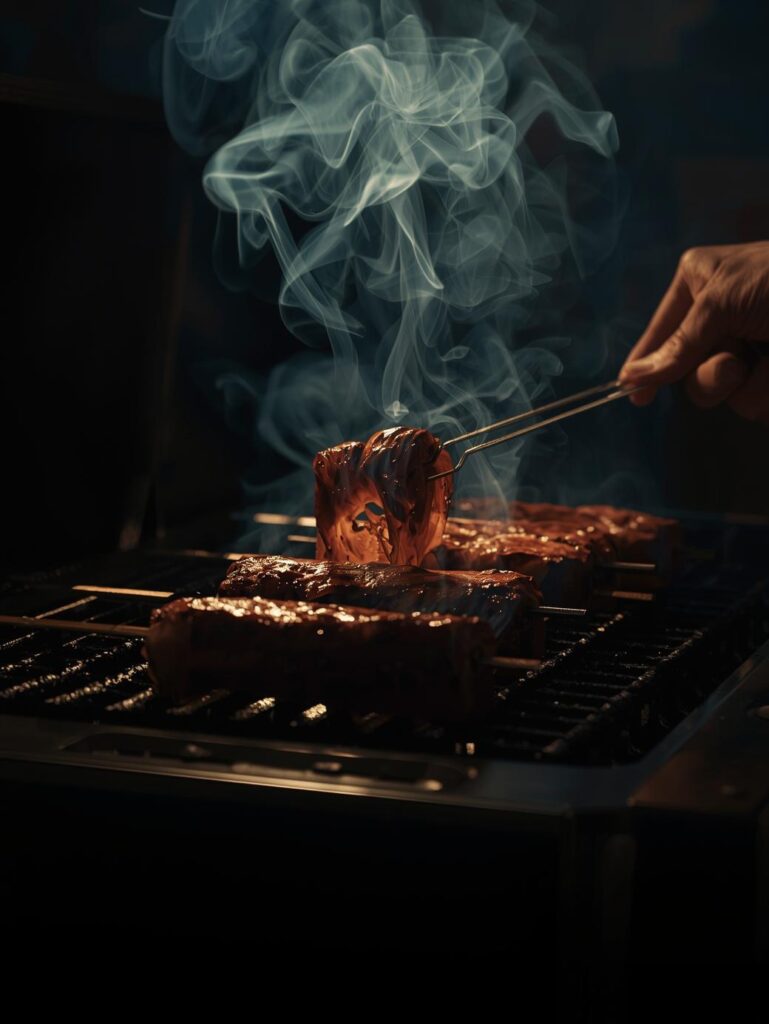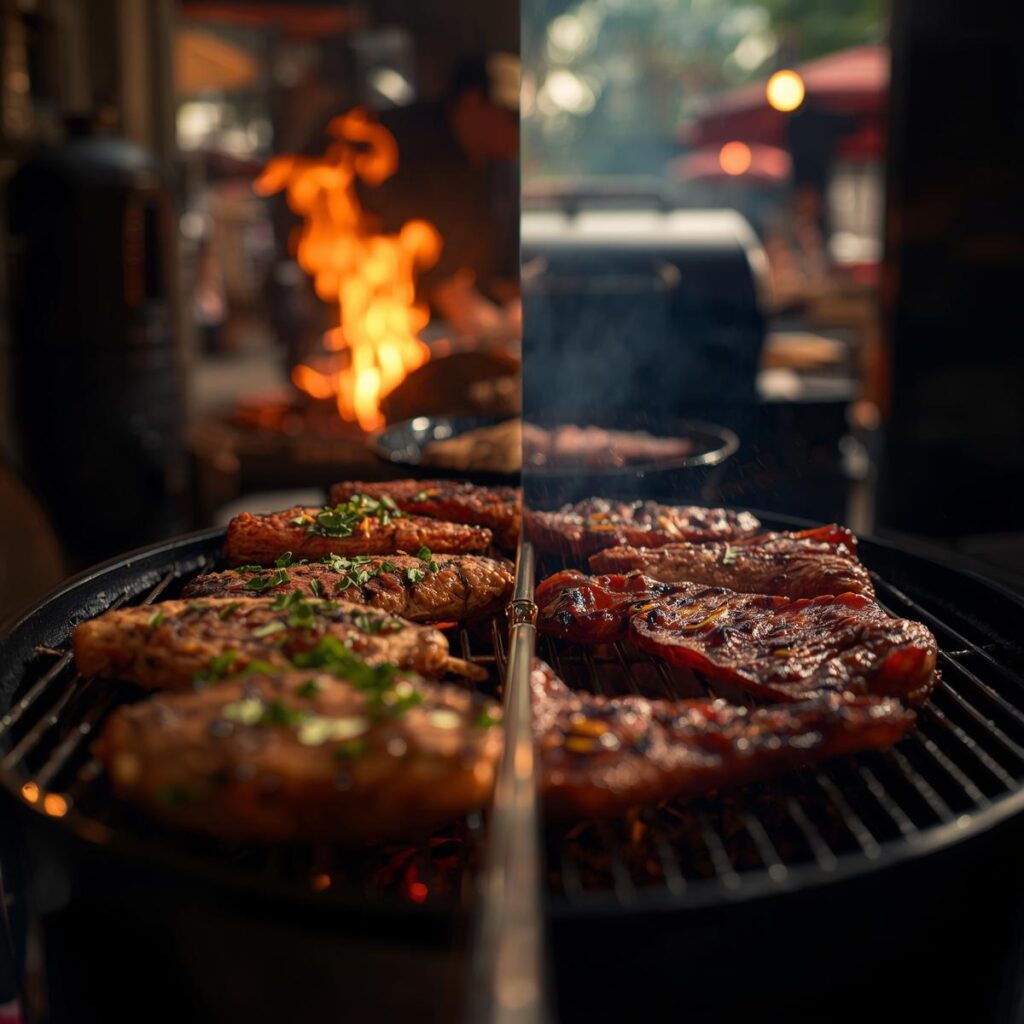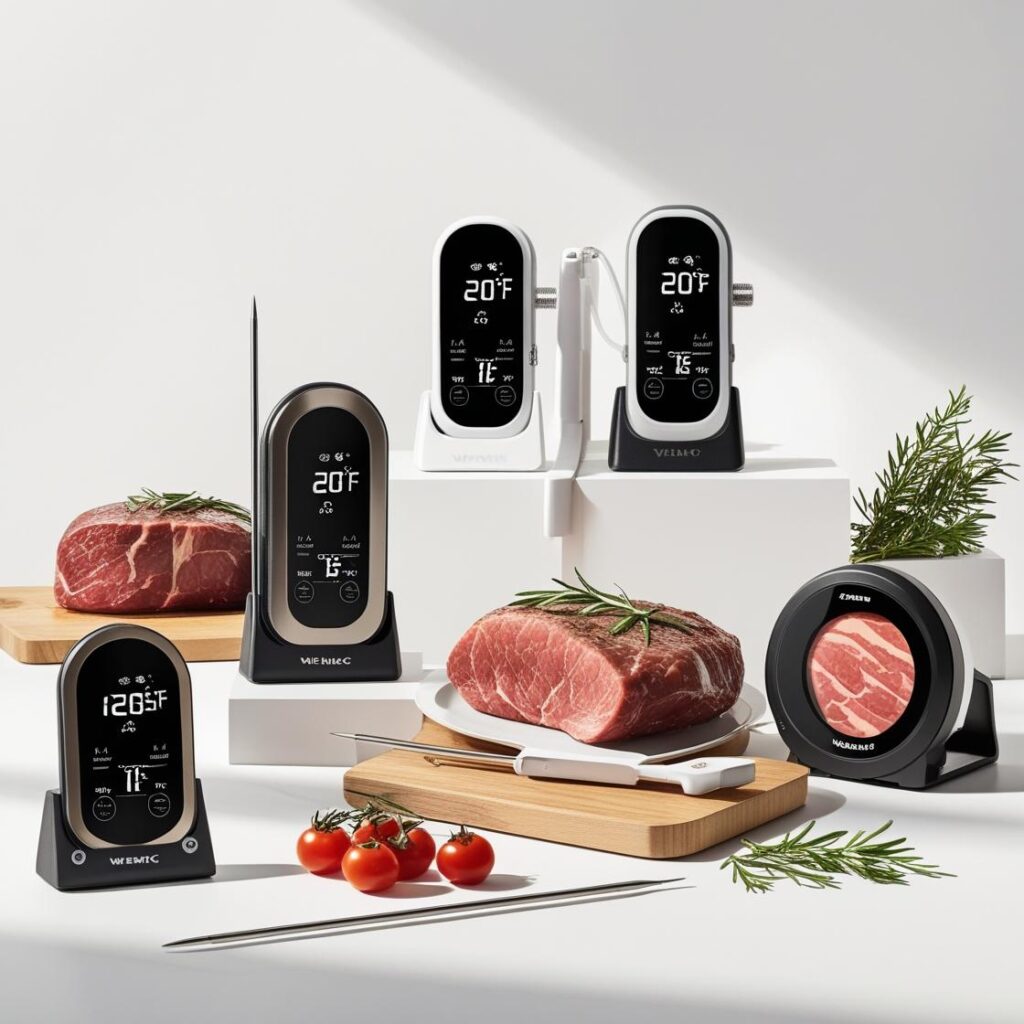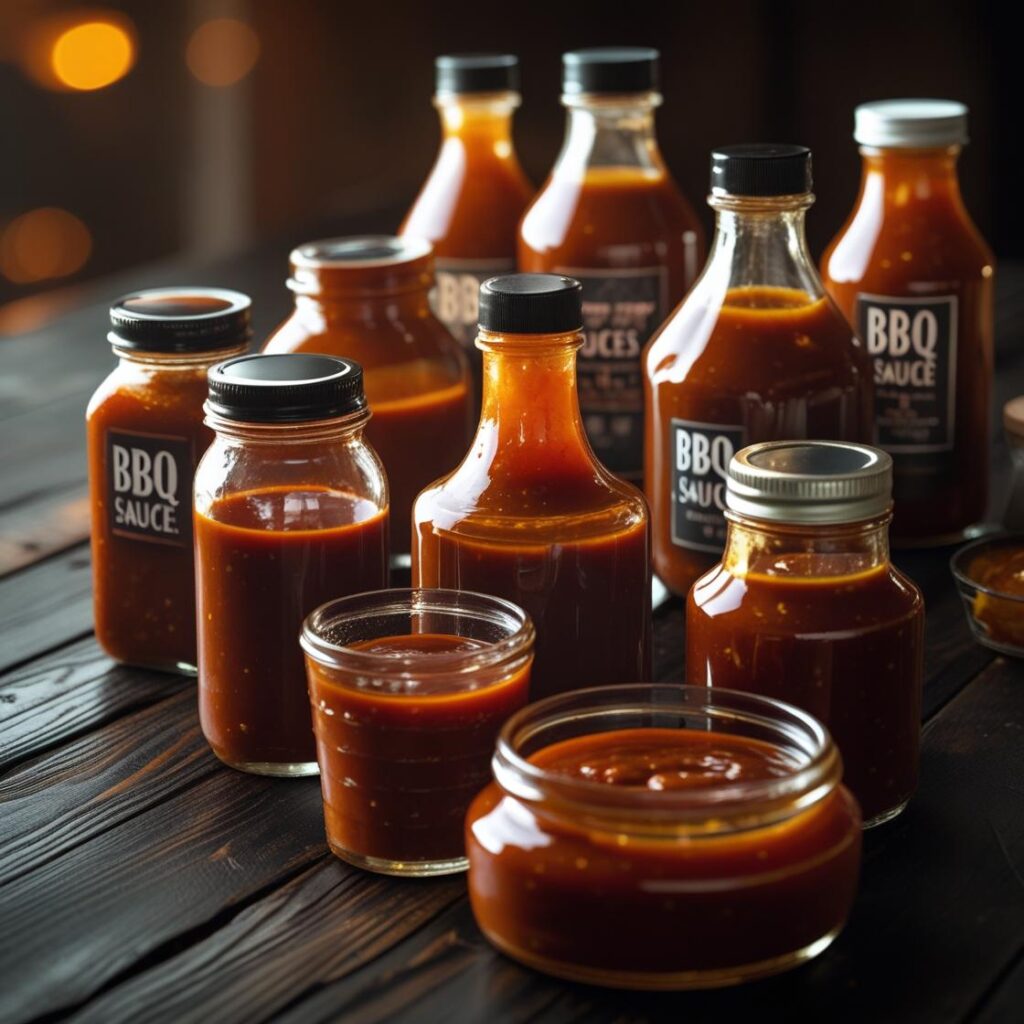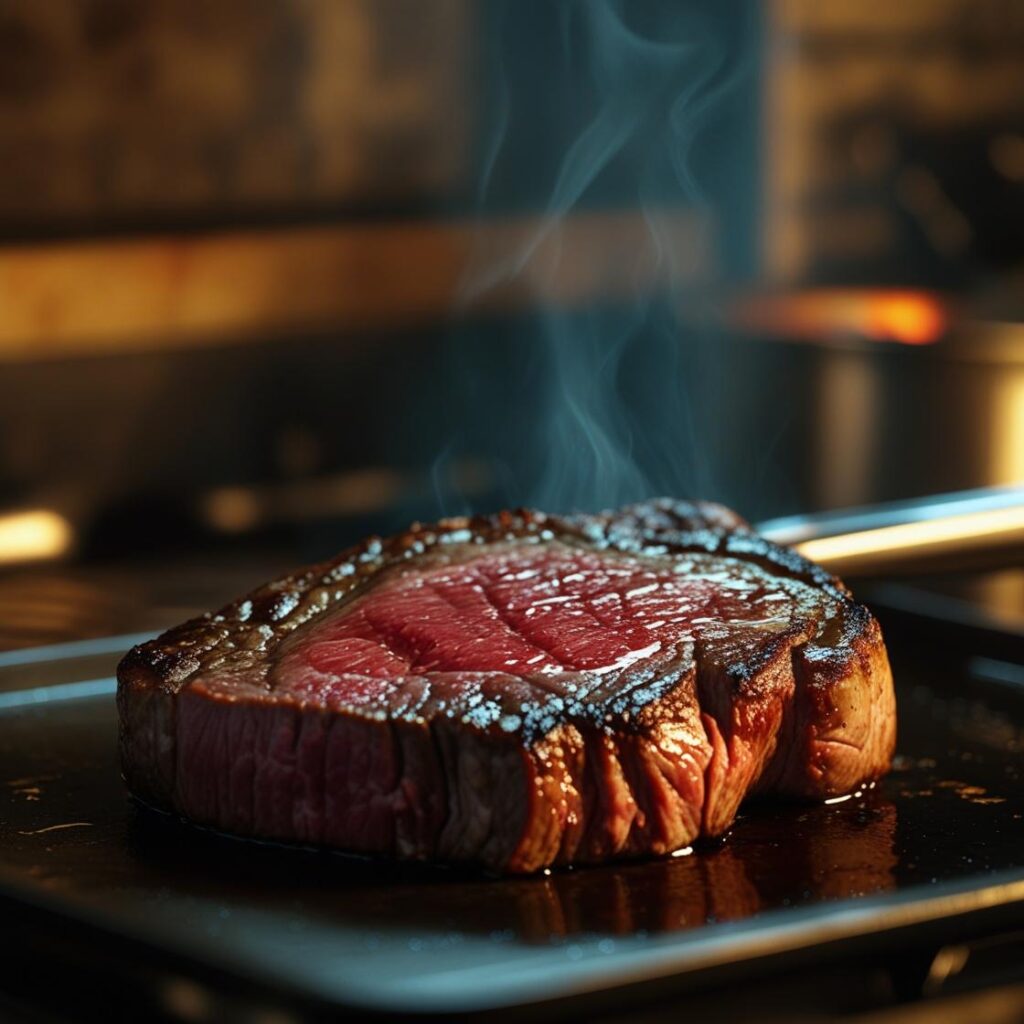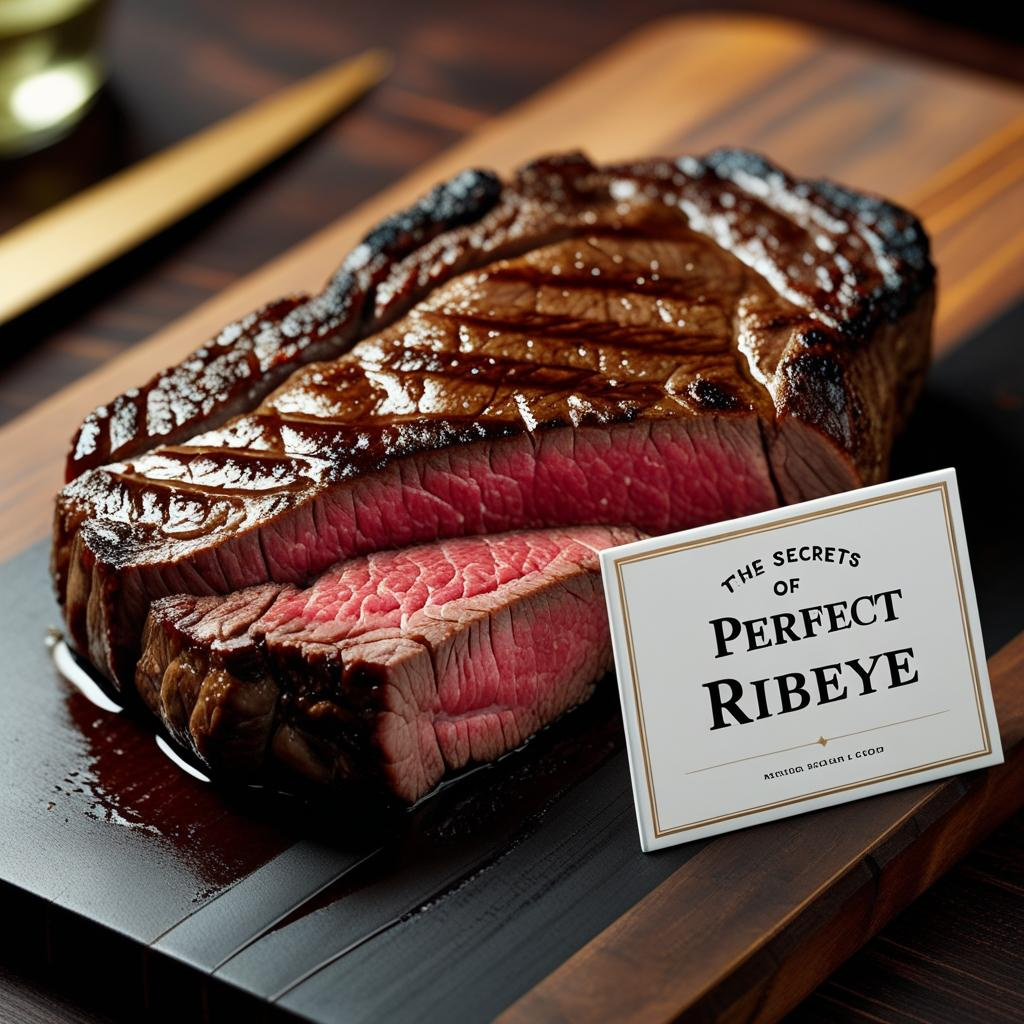Expert’s Note: This comprehensive encyclopedia from our BBQ Methods Encyclopedia represents the definitive guide to understanding fire, heat, and flavor transformation. Smoking and grilling aren’t just different cooking methods—they’re different philosophical approaches to fire management that produce dramatically different results. Master both, and you become a complete fire artist.
SMOKING VS GRILLING: THE COMPLETE ENCYCLOPEDIA
“Smoking and grilling represent the yin and yang of fire cooking—one patient and transformative, the other immediate and intense. Smoking is like a slow, careful conversation with your meat, gradually persuading tough connective tissue to become tender. Grilling is a passionate argument with heat, creating instant crust and capturing natural juices. Understanding both isn’t just about technique; it’s about speaking the complete language of fire.”
Smoking vs Grilling: The Complete Encyclopedia (2025) – Master Both Methods
Download our free Smoking vs Grilling Decision Matrix to instantly choose the right method for any cut.
The age-old debate between smoking and grilling represents one of the most fundamental divisions in the world of outdoor cooking. While many use the terms interchangeably, they represent completely different approaches to heat application, time investment, and flavor development. This 4000+ word encyclopedia doesn’t just compare these methods—it provides the deepest understanding ever compiled of when, why, and how to use each technique to achieve specific culinary outcomes. Whether you’re a weekend warrior or aspiring pitmaster, this guide will transform your relationship with fire.
🔬 THE FUNDAMENTAL PHYSICS: UNDERSTANDING HEAT TRANSFER
Before comparing methods, we must understand the basic physics that govern all meat cooking.
⚙️ The Three Mechanisms of Heat Transfer
How Heat Actually Cooks Your Food
- Conduction (Direct Contact): Heat transfer through direct physical contact with a hot surface. This is the primary mechanism in grilling when food touches hot grates, and in pan-searing. The efficiency depends on the contact quality—this is why pressing burgers creates better crust but squeezes out juices.
- Convection (Air/Liquid Movement): Heat transfer through circulating hot air or liquid. In smoking, convection dominates as heated air circulates around the meat. In grilling, convection plays a secondary role but becomes crucial when the lid is closed, creating an oven-like environment. Convection cooking is generally more even than conduction.
- Radiation (Electromagnetic Waves): Heat transfer through infrared waves without heating the intervening air. In grilling, radiant heat comes from hot coals, ceramic briquettes, or infrared burners. In smoking, radiation is minimal but present from smoker walls. Radiant heat is why you feel warmth standing near a fire without touching it.
Each cooking method combines these mechanisms in different proportions, creating distinct cooking environments.
🎯 The Maillard Reaction vs. Collagen Breakdown
❌ Maillard Reaction (Grilling Focus)
- Temperature: Occurs rapidly at 280°F+ (138°C+)
- Process: Amino acids + reducing sugars create new flavor compounds
- Result: Browned crust, complex flavors, appealing appearance
- Optimal Environment: Dry surface, high heat, direct exposure
- Limitation: Only affects surface, requires careful timing
✅ Collagen Breakdown (Smoking Focus)
- Temperature: Occurs slowly at 160°F+ (71°C+) over time
- Process: Collagen triple helix unwinds into gelatin
- Result: Tough cuts become tender, moist mouthfeel
- Optimal Environment: Low temperatures, extended time, moisture
- Limitation: Requires hours, not suitable for tender cuts
📚 HISTORICAL ORIGINS: HOW EACH METHOD EVOLVED
Understanding the cultural and practical origins reveals why each method developed for specific purposes.
🌍 Global Evolution of Cooking Methods
The Ancient Division of Labor
- Smoking Origins (Preservation First): Dating back 90,000 years to early Homo sapiens, smoking began as a preservation method. Indigenous peoples worldwide used smoke to extend the life of meat, fish, and other foods. The antimicrobial properties of smoke compounds like phenols and formaldehyde prevented spoilage, while the drying effect reduced available moisture for bacteria. This was never originally about flavor—it was about survival.
- Grilling Origins (Immediate Consumption): Evidence suggests early humans began grilling over open flames approximately 1.8 million years ago. The discovery of fire led to direct-heat cooking as the fastest way to make meat digestible and safe. Caribbean indigenous peoples developed the barbacoa framework that would evolve into modern grilling, while Asian cultures developed yakitori and other direct-heat methods.
- The Cultural Split: Smoking evolved prominently in colder climates where preservation was essential (Scandinavia, Eastern Europe, Native American traditions). Grilling flourished in warmer climates where immediate consumption was practical (Mediterranean, Caribbean, Southeast Asia). This geographical divide still influences regional preferences today.
Explore more in our Global BBQ Culture Guide.
🇺🇸 American Evolution: The Great Divide
Smoking in America
- 1700s: German and Czech immigrants bring smoking traditions to Texas
- 1800s: African slaves develop pit-smoking techniques in the South
- Early 1900s: Meatpacking industry popularizes smoked meats
- 1950s: Backyard smokers become commercially available
- 1980s-Present: Competition BBQ elevates smoking to art form
Grilling in America
- Post-WWII: Suburban expansion and charcoal availability
- 1950s: Weber Kettle revolutionizes backyard grilling
- 1960s: Gas grills introduce convenience
- 1980s-90s: Gourmet grilling and celebrity chefs
- 2000s-Present: Artisanal grilling and technique refinement
Historical Insight: The Economic Divide. Smoking traditionally used cheaper, tougher cuts of meat that required transformation (brisket, pork shoulder). Grilling used more expensive, naturally tender cuts (steaks, chops) that needed minimal intervention. This economic reality shaped the class associations that still persist in barbecue culture today.
🔥 THE COMPLETE METHODOLOGY BREAKDOWN
Now we dive into the precise technical specifications that define each method.
🌡️ Temperature Ranges: The Fundamental Difference
The Thermal Spectrum Defined
- Cold Smoking (65-85°F): True preservation method, not cooking. Used for salmon, cheese, nuts. Meat remains raw but takes on smoke flavor. Requires separate smoke generation and careful temperature control.
- Hot Smoking (200-275°F): The sweet spot for barbecue. Slow cooking with smoke flavor penetration. Ideal for pork shoulder, brisket, ribs. The “low and slow” method that transforms collagen to gelatin.
- Grilling (350-550°F): Direct heat cooking for rapid surface development. Perfect for steaks, burgers, chops, vegetables. Creates Maillard reaction crust while keeping interior moist.
- Searing (550°F+): Extreme heat for crust development. Often used in combination with other methods (reverse sear). Requires specialized equipment or techniques.
Each temperature range serves specific purposes and achieves different transformations.
⏱️ Time Investment: Patience vs. Immediacy
🎯 Time Comparison by Cut Type
| Cut Type | Smoking Time | Grilling Time | Time Ratio |
|---|---|---|---|
| Brisket (12 lbs) | 12-16 hours | Not Recommended | N/A |
| Pork Shoulder (8 lbs) | 8-12 hours | Not Recommended | N/A |
| Ribeye Steak (1.5″) | 2-3 hours (reverse sear) | 8-12 minutes | 15:1 |
| Pork Chops (1″) | 1.5-2 hours (smoke finish) | 6-8 minutes | 18:1 |
| Chicken Thighs | 2-3 hours | 15-20 minutes | 8:1 |
| Salmon Fillet (1″) | 1-2 hours | 6-8 minutes | 15:1 |
| Vegetables (Mixed) | 1-1.5 hours | 8-15 minutes | 7:1 |
🎯 THE ULTIMATE CUT SELECTION GUIDE
Choosing the right method for each cut is the most critical decision in fire cooking.
🥩 Beef Cut Methodology Matrix
🎯 Beef Cooking Method Recommendations
| Cut | Smoking | Grilling | Hybrid | Notes |
|---|---|---|---|---|
| Brisket | ⭐️⭐️⭐️⭐️⭐️ | ❌ | ⭐️⭐️⭐️ | Requires collagen breakdown |
| Ribeye | ⭐️⭐️ | ⭐️⭐️⭐️⭐️⭐️ | ⭐️⭐️⭐️⭐️⭐️ | Excellent for reverse sear |
| Short Ribs | ⭐️⭐️⭐️⭐️⭐️ | ❌ | ⭐️⭐️⭐️ | Beef ribs need slow rendering |
| Filet Mignon | ⭐️⭐️ | ⭐️⭐️⭐️⭐️⭐️ | ⭐️⭐️⭐️⭐️ | Too lean for long smoking |
| Tri-Tip | ⭐️⭐️⭐️ | ⭐️⭐️⭐️⭐️ | ⭐️⭐️⭐️⭐️⭐️ | Perfect hybrid candidate |
| Chuck Roast | ⭐️⭐️⭐️⭐️⭐️ | ❌ | ⭐️⭐️⭐️ | “Poor man’s brisket” |
| Skirt Steak | ❌ | ⭐️⭐️⭐️⭐️⭐️ | ⭐️⭐️ | Best hot and fast |
🐖 Pork Cut Methodology Matrix
🎯 Pork Cooking Method Recommendations
| Cut | Smoking | Grilling | Hybrid | Notes |
|---|---|---|---|---|
| Pork Shoulder | ⭐️⭐️⭐️⭐️⭐️ | ❌ | ⭐️⭐️ | Pulled pork requires smoking |
| Pork Chops | ⭐️⭐️ | ⭐️⭐️⭐️⭐️⭐️ | ⭐️⭐️⭐️⭐️ | Grilling preserves juiciness |
| Baby Back Ribs | ⭐️⭐️⭐️⭐️⭐️ | ⭐️⭐️⭐️ | ⭐️⭐️⭐️⭐️ | 3-2-1 method ideal |
| Pork Belly | ⭐️⭐️⭐️⭐️⭐️ | ⭐️⭐️⭐️ | ⭐️⭐️⭐️⭐️ | Smoke then crisp |
| Pork Tenderloin | ⭐️⭐️⭐️ | ⭐️⭐️⭐️⭐️⭐️ | ⭐️⭐️⭐️⭐️ | Lean, quick-cooking |
| Spare Ribs | ⭐️⭐️⭐️⭐️⭐️ | ⭐️⭐️ | ⭐️⭐️⭐️⭐️ | More fat than baby backs |
🛠️ EQUIPMENT DEEP DIVE: TOOLS FOR EACH METHOD
The right equipment dramatically affects your results with each cooking method.
🔥 Smoker Types: Specialized Equipment Analysis
Comprehensive Smoker Comparison
- Offset Smokers (Traditional): Separate firebox allows pure smoke and convection heat. Requires constant attention but delivers authentic results. Temperature management is manual and challenging. Best for purists and competition cooks. Fuel: wood splits or charcoal.
- Pellet Smokers (Modern Convenience): Automated temperature control via wood pellet fuel. Set-and-forget operation with consistent results. Less smoky flavor than offsets but incredibly convenient. Digital controls and Wi-Fi connectivity. Fuel: wood pellets.
- Kamado Grills (Versatile): Ceramic construction provides excellent heat retention and efficiency. Can smoke low-and-slow or grill high-heat. Temperature control requires practice but is very stable once mastered. Fuel: charcoal with wood chunks.
- Electric Smokers (Beginner Friendly): Plug-in operation with minimal supervision. Consistent temperatures but weaker smoke flavor. Some models don’t work well in cold weather. Good for apartments or beginners. Fuel: electricity with wood chips.
- Water Smokers (Bullet Style): Vertical design with water pan for moisture. Excellent for maintaining steady low temperatures. Affordable and great for learning. Limited capacity and requires refilling. Fuel: charcoal with wood chunks.
⚡ Grill Types: Heat Source Technology
Comprehensive Grill Comparison
- Charcoal Grills (Classic): Intense, dry heat perfect for searing. Flavor from fat dripping on coals. Temperature control via vent manipulation. Requires cleanup and more time. Kettle grills offer excellent versatility with two-zone cooking.
- Gas Grills (Convenience): Instant heat with precise temperature control. Consistent results and easy cleanup. Less flavor development than charcoal. Infrared options provide superior searing capability. Propane or natural gas options.
- Pellet Grills (Hybrid): Can both grill and smoke, though neither perfectly. Good smoke flavor with set-and-forget operation. Less intense direct heat than dedicated grills. Excellent for people who want one device for everything.
- Flat Top Grills (Versatile): Large solid cooking surface ideal for smash burgers, breakfast, stir-fry. Even heating and easy temperature zones. Retains juices and flavors on cooking surface. Different experience than open grates.
- Infrared Grills (Professional): Intense radiant heat for exceptional searing. Heats incredibly fast with precise control. Prevents flare-ups and cooks evenly. Can be too intense for delicate foods. Often found in high-end models.
🎯 FLAVOR PROFILES: THE CHEMISTRY OF SMOKE VS. SEAR
The fundamental chemical processes create dramatically different flavor experiences.
🌫️ Smoke Flavor Chemistry
The Science of Smoke Penetration
- Phenols (Antimicrobial/Smoky): These compounds provide the characteristic smoky aroma and flavor while also preserving the meat. Guaiacol and syringol are the primary phenols responsible for the “smoky” taste we recognize. Different woods produce different phenol profiles.
- Carbonyls (Sweetness): Compounds like furans and furanones provide sweet, caramel-like notes. These develop from the breakdown of cellulose and hemicellulose in wood. The balance between phenols and carbonyls determines whether smoke tastes harsh or sweet.
- Acids (Tanginess): Acetic acid and other organic acids contribute slight vinegar-like notes that brighten rich meats. These help balance the heaviness of smoked fats and contribute to the overall complexity.
- Smoke Penetration Depth: Contrary to popular belief, smoke only penetrates about 1/8 inch into the meat surface. The “smoke ring” is a chemical reaction, not deeper penetration. Most smoke flavor resides in the bark and outer layers.
🔥 Maillard Reaction Chemistry
The Science of Browning
- Amino Acid + Sugar Reactions: When temperatures reach 280°F+, amino acids (from proteins) react with reducing sugars to create hundreds of new flavor compounds. This is why seared meat tastes fundamentally different from boiled meat.
- Pyrazines (Nutty/Earthy): These compounds create roasted, nutty flavors reminiscent of coffee, cocoa, and toasted bread. They develop more extensively in grilling than smoking due to higher temperatures.
- Furans (Caramel/Sweet): Sweet compounds that develop from sugar caramelization. These provide the caramel notes in well-seared meat and contribute to aroma complexity.
- Thiazoles (Meaty/Savory): Sulfur-containing compounds that create meaty, savory flavors. These are particularly important in creating the “umami” character of grilled meats.
🚀 HYBRID TECHNIQUES: THE BEST OF BOTH WORLDS
Modern cooking often combines methods to achieve specific results unattainable with单一 approach.
🔄 The Reverse Sear Revolution
Smoke Then Sear Methodology
- Process: Cook meat slowly at low temperature (200-225°F) to 10-15°F below target doneness, then sear at high heat (500°F+) to develop crust
- Benefits: Perfect edge-to-edge doneness, superior crust development, flexible timing, reduced guesswork
- Ideal Cuts: Thick steaks (1.5″+), pork chops, lamb racks, prime rib
- Equipment: Two-zone grill, smoker + grill combo, or oven + skillet
- Timing: Low heat phase 45-90 minutes, sear phase 60-90 seconds per side
Learn the complete method in our Reverse Searing 2026 Guide.
⚡ Hot and Fast Smoking
Accelerated Low & Slow
- Process: Smoke at 275-325°F instead of traditional 225°F, reducing cook time by 30-40%
- Benefits: Faster results, better bark development, reduced stall effect, more efficient fuel use
- Ideal Cuts: Pork shoulder, brisket, ribs, poultry
- Considerations: Requires closer monitoring, slightly less smoke absorption, different texture
- Results: Nearly identical to traditional methods when mastered
📊 DECISION MATRIX: CHOOSING YOUR METHOD
This comprehensive matrix helps you instantly select the right method for any situation.
🎯 Ultimate Method Selection Matrix
| Factor | Choose Smoking When… | Choose Grilling When… |
|---|---|---|
| Time Available | 4+ hours available for cooking | Under 2 hours total time |
| Cut Type | Tough, fatty cuts with collagen | Tender, quick-cooking cuts |
| Desired Texture | Fall-apart tender, pulled meat | Firm, juicy, with resistance |
| Flavor Profile | Complex, smoky, earthy notes | Clean, beefy, caramelized notes |
| Cooking Experience | Patient, methodical approach | Active, engaged cooking |
| Weather Conditions | Cool, calm days ideal | Any conditions work |
| Guest Expectations | Comfort food, traditional BBQ | Steakhouse experience |
| Equipment Available | Smoker or indirect capable grill | Any grill or even skillet |
| Skill Level | Intermediate to advanced | Beginner to expert |
🌍 REGIONAL VARIATIONS: CULTURAL APPROACHES
Different cultures have developed distinct preferences and techniques for each method.
🇺🇸 American Regional Styles
The Great American Divide
- Texas (Smoking Dominant): Beef-centric smoking tradition focusing on brisket, beef ribs, and sausage. Central Texas style uses salt and pepper rub with post oak smoke. East Texas incorporates more sauce and sweetness. Emphasis on meat quality and simple seasoning.
- Carolinas (Whole Hog Focus): Smoking entire hogs over oak or hickory, then chopping or pulling the meat. Vinegar-based sauces in Eastern NC, mustard-based in SC, tomato-based in Western NC. Long smoking traditions dating to colonial times.
- Kansas City (Balanced Approach): Both smoking and grilling traditions with sweet, tomato-based sauces. Burnt ends from smoked brisket points, but also grilled steaks and chops. The true crossroads of American barbecue.
- Memphis (Rib Culture): Famous for dry-rubbed smoked ribs, but also grilled ribeye and pork chops. “Dry” vs. “wet” rib traditions, with dry-rubbed being the signature style. Strong grilling culture for steaks and chops alongside smoking tradition.
Explore more in our American BBQ Regional Bible.
🌏 International Approaches
Global Fire Cooking Traditions
- Argentinian Asado (Grilling Mastery): Focus on direct heat grilling over wood embers. Simple salt seasoning to highlight meat quality. Various cuts cooked to different doneness levels. Social event centered around the fire.
- Japanese Yakitori (Precision Grilling): Skewered ingredients grilled over binchotan charcoal. Precise temperature control and timing. Multiple courses served in progression. Emphasis on technique and ingredient quality.
- Korean BBQ (Tabletop Grilling): Diners grill their own meat at the table. Thinly sliced meats cooked quickly. Complex marinades and accompaniments. Social, interactive dining experience.
- German Räucher (Smoking Tradition): Cold smoking for preservation of sausages and hams. Specific wood types for different products. Regional variations in spice blends and techniques. Centuries-old traditions.
🚨 TROUBLESHOOTING: COMMON PITFALLS AND SOLUTIONS
🎯 Method-Specific Problem Solving
| Problem | Smoking Solution | Grilling Solution |
|---|---|---|
| Dry, Tough Results | Cook to tenderness, not time; use water pan; wrap at stall | Don’t overcook; use thermometer; rest properly |
| Bitter Flavor | Use clean smoke; avoid creosote; proper wood selection | Clean grates; avoid lighter fluid; manage flare-ups |
| Uneven Cooking | Rotate meat; manage hot spots; use consistent temp | Use two-zone setup; rotate frequently; manage heat |
| Poor Bark/Crust | Proper rub; spritz management; unwrapped time | Dry surface; sufficient heat; don’t move too early |
| Temperature Issues | Fire management; insulation; weather adjustment | Vent control; burner adjustment; preheating time |
| Timing Problems | Plan for stall; buffer time; hold finished meat | Mise en place; thermometer use; rest time included |
🏁 MASTERING THE COMPLETE FIRE ARSENAL
The true mastery of outdoor cooking isn’t choosing between smoking and grilling—it’s understanding when each method serves your goals and how they can work together. Like a skilled artist who knows when to use a broad brush versus fine detail work, the complete fire master selects the right tool for each culinary challenge.
Smoking represents the patient, transformative approach that turns tough cuts into tender masterpieces through time and subtle smoke influence. Grilling represents the immediate, intense approach that highlights quality ingredients through rapid heat application and crust development. Neither is superior—they’re complementary tools in the complete outdoor cook’s arsenal.
The future of fire cooking lies in understanding the physics behind each method, the chemistry of flavor development, and the practical considerations of time, equipment, and desired outcomes. The modern pitmaster doesn’t pledge allegiance to one method but develops fluency in both, creating a complete vocabulary of fire expression.
Your journey to complete fire mastery begins with recognizing that smoking and grilling aren’t competitors—they’re partners in the pursuit of perfect results. Learn the fundamentals of each, practice both extensively, and gradually develop the intuition to know instantly which method (or combination) will achieve your desired outcome. When you can look at any cut of meat and visualize its perfect transformation through fire, you’ve achieved true mastery.
The fire doesn’t care about labels—it only responds to understanding. Whether you’re patiently maintaining 225°F for hours or searing at 600°F for minutes, you’re speaking the same ancient language of transformation through heat. Master both dialects, and you become truly fluent in the art of fire.
Continue Your Fire Education: Master every aspect of heat management with our complete resource collection:

